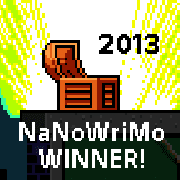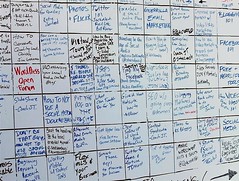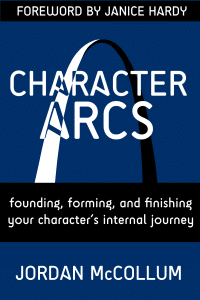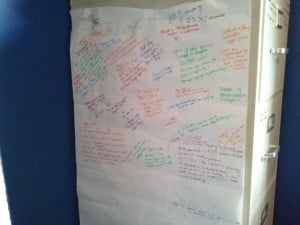Every year around NaNoWriMo, the same articles start springing up: how to write faster. Why I’m not doing Nano. Why I am doing Nano. Nano is anathema to real writers. Writing fast can only produce schlock. Writing fast is not a valid career plan.
I disagree. But I’m biased. Of my last five novels, four were written in a month or less (a piece), some during NaNoWriMo, some not. So far I’ve published two of those novels—one fast one, and the slowest novel I’ve ever written. Both were finalists for an award.
There is the general idea out there that something done fast is shoddy, as if someone who writes a manuscript quickly is required to throw it up on Amazon the next week. But that just isn’t the case.
I see no reason at all why anyone can claim that writing fast isn’t a valid career plan. (There are authors out there who write fast, publish quickly, and rake in the dough. Sounds like a career plan to me, though it isn’t quite mine.)
But writing fast isn’t for everyone. How do you know if writing fast is a good idea for you? Here are five factors to consider.
This ain’t your first rodeo
Writing a first novel this quickly is probably not a great idea. (Okay, I did write my first “novel” in about four weeks, but it ended up being pretty short. I also wrote it longhand. You don’t have to be like me.) It takes practice to develop the necessary storytelling skills and basic writing skills to come out of a fast draft with something workable, or even the beginnings of something workable.
Once you’ve established your writing skills and storytelling skills, you can tap into those strengths to help you write faster and come out with something that’s just as coherent as most “slow” first drafts.
You love the immersive experience of writing
I love getting lost in my own story. When I’m drafting, I live and breathe my characters’ lives. I imagine new scenes all the time. I practice dialogue. I research, I design, I plot.
If you live and breathe your stories while drafting, writing faster and writing more makes that experience even more immersive. You’re really living your characters’ story, perhaps almost in real time.
Plus, once you’ve made it through those few weeks, you can get the house clean and caught up on laundry (ha!).
You can make connections
One of the big advantages of writing a book in two or three weeks is that you’ve lived all the events in your recent memory. You might not be able to hold every detail in your short term memory, but your subconscious sometimes hangs on to important symbols, characters, events and story threads that you might forget otherwise, and have to come and weave in later. If you’re good at making these kinds of connections, writing fast could make you even better.
You can shut up the inner editor
You can’t write quickly if you’re rewriting every sentence five times. (If you type and think fast, you might be able to get away with rewriting the occasional sentence 2-3 times. Not that I’ve done that. . . .) But no matter how fast or slow you write, during drafting you should usually turn off the inner editor—not the “subject-verb agreement” portion of your brain, but the nagging self-doubts that can shut down your creativity.
You’re willing to put in the time to edit AFTER drafting
Only a Sith deals in absolutes, but I’m going to go to the dark side for a minute: ALL FIRST DRAFTS NEED EDITING. Whether you labored over your first draft for three years or three weeks, there are things you’ll have to go back and fix. (In fact, I’d argue that if it’s been three years since you began your novel, you might not even remember some pretty important pieces, and you might need some serious rewriting.) Most of my fast books have required medium-to-major rewrites. All of my slow books have required medium-to-major rewrites.
In my experience, the quality of a manuscript isn’t necessarily correlated with the speed at which it was written. But you don’t have to take my word for it. Just ask Arthur Conan Doyle (A Study in Scarlet, Sherlock Holmes’s premiere), Alexandre Dumas (The Knight of the Red House), Muriel Spark (The Prime of Miss Jean Brodie), Stephen King (The Running Man), Jack Kerouac (On the Road), Fyodor Dostoyevskiy (The Gambler—while also writing ) or Robert Louis Stevenson (The Strange Case of Dr. Jekyll and Mr. Hyde). These books, many of them bestsellers and/or classics, were written in anywhere from 66 hours to 4 weeks.
Maybe writing fast will work for you; maybe it won’t. But it’s definitely a viable career plan, and I enjoy writing that way (most of the time), so I see no reason to stop, NaNo or no.
What do you think? Do you write fast? Have you ever tried it?
Photo by The Hamster Factor
![107/365 [Flying Fingers]](http://farm4.staticflickr.com/3593/3454110496_b3785204f5.jpg)


 I hope you’re a bit farther along in your goals—in fact, maybe you’re starting to hit the 30k slump. Here are a few quick ways to recharge and reconnect with your WIP.
I hope you’re a bit farther along in your goals—in fact, maybe you’re starting to hit the 30k slump. Here are a few quick ways to recharge and reconnect with your WIP. 



 When I started writing again after a five-year break, it was like riding a bike. I jumped in headfirst, but I was soon thrown off balance. Everything was a bit wobbly, and it took me a full year to get to a place where I was riding straight without fear of breaking my neck. The last thing I wanted to do was make a fool of myself, so I worked on one project until I realized I wasn’t going to get far if I didn’t start working on something different. Let’s say I couldn’t see the forest for the trees.
When I started writing again after a five-year break, it was like riding a bike. I jumped in headfirst, but I was soon thrown off balance. Everything was a bit wobbly, and it took me a full year to get to a place where I was riding straight without fear of breaking my neck. The last thing I wanted to do was make a fool of myself, so I worked on one project until I realized I wasn’t going to get far if I didn’t start working on something different. Let’s say I couldn’t see the forest for the trees.
